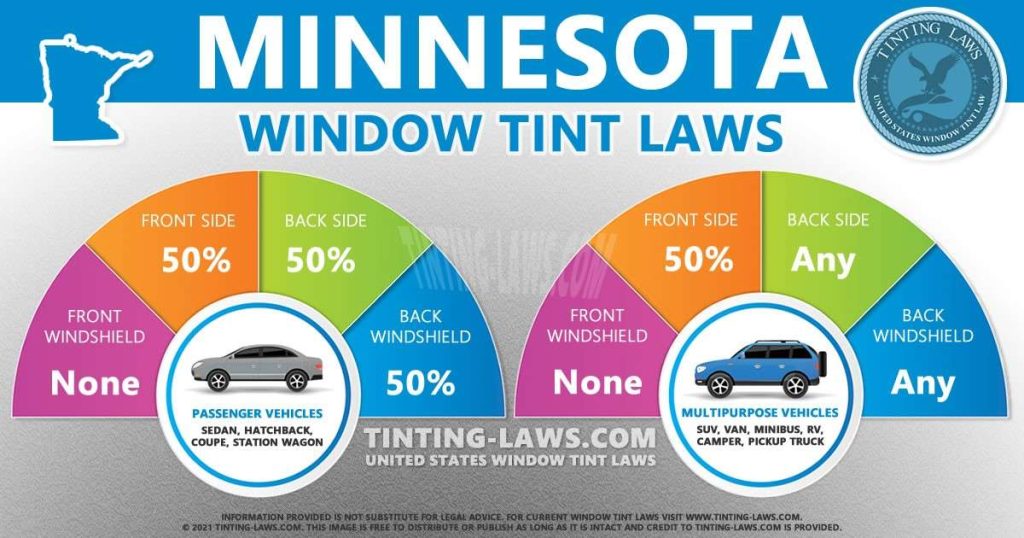Minnesota Window Tinting Laws
Car window tinting laws in Minnesota were enacted in 1985.
We have provided all the necessary information about your car’s window tint, including how dark or reflective the tint is allowed in your state.
There are also additional car window tinting rules and regulations in Minnesota so make sure you read all about it below.
Window tint darkness in Minnesota
The percent of visible light allowed through your car windows is called VLT: Visible Light Transmission.
The percentage of light allowed through your film and glass in Minnesota is very specific and different for sedan cars and SUV cars or vans.
Tint darkness for sedans:
- Windshield: No tint is allowed on the windshield.
- Front Side windows: Must allow more than 50% of light in.
- Back Side windows: Must allow more than 50% of light in.
- Rear Window: Must allow more than 50% of light in.
Tint darkness for SUV and vans:
- Windshield: No tint is allowed on the windshield.
- Front Side windows: Must allow more than 50% of light in.
- Back Side windows: Any darkness can be used.
- Rear Window: Any darkness can be used.
Window tint reflection in Minnesota
Window tint can reflect incoming light and reduce glare and heat.
Minnesota window tint law permits a certain window reflection when using a tint so make sure you pay attention to this as well.
Tint reflection for sedans:
- Front Side windows: Must not be more than 20% reflective.
- Back Side windows: Must not be more than 20% reflective.
Tint reflection for SUV and vans:
- Front Side windows: Must not be more than 20% reflective.
- Back Side windows: Must not be more than 20% reflective.
Other Minnesota window tint rules and regulations:
Minnesota does have several other important laws, rules and regulations pertaining to window tinting. They include the following:
- Side Mirrors: There are no restrictions or requirements for side mirrors in Minnesota.
- Restricted Colors: No colors of tint are explicitly restricted from use.
- Tint Variance: 3% variance allowed.
- Certificates: Manufacturers do NOT need to certify the film they sell in the state.
- Stickers: The sticker to identify legal tinting is required between the film & glass on the driver’s side window.
- Medical Exceptions: Minnesota allows medical exemptions for special tint.
Keep in mind that Minnesota tinting laws and regulations may be interpreted differently in your county or place of residence.
We always recommend double-checking our information with your local DMV or law enforcement authorities.

Our information about window tint laws in Minnesota was last updated in 2024.
Tinting laws in Minnesota were enacted in 1985.
In case any of our info provided is not up to date or correct be sure to contact us so we can fix it. Thanks!
Trusted industry leader in providing accurate window tint laws. Share with confidence:
State of Minnesota Info
Minnesota is a U.S. state in the Midwestern United States.
Minnesota was carved out of the eastern half of the Minnesota Territory and admitted to the Union as the 32nd state on May 11, 1858.
Known as the “Land of 10,000 Lakes”, the state’s name comes from a Dakota word for “sky-tinted water”.

Those waters, together with forests, parks, and wilderness areas, offer residents and tourists a variety of outdoor recreational opportunities.
Minnesota is the 12th most extensive and the 21st most populous of the U.S. States.
Capital: Saint Paul
Population: 5,379,139
Area: 86,939 sq mi (225,181 km2)
Cities in Minnesota: Minneapolis, Saint Paul, Duluth, Minnetonka, Bloomington, Edina, Rochester, Mankato, St. Cloud, Eden Prairie, Bearville Township, Burnsville, Eagan, Maple Grove, Bemidji, Stillwater, Red Wing, Vergas, Staples, Brainerd, Brooklyn Park, Lakeville, St. Louis Park, Plymouth, Winona, Shakopee, Moorhead, Woodbury, Coon Rapids, Apple Valley, Sax, Walnut Grove, Roseville, Chanhassen, Alexandria, Northfield, Blaine, Rosemount, Chaska, New Ulm, Golden Valley, Willmar, Prior Lake, Wayzata, Ely, Grand Rapids, Faribault, Inver Grove Heights, Owatonna, White Bear Lake
Counties in Minnesota: Aitkin, Anoka, Becker, Beltrami, Benton, Big Stone, Blue Earth, Brown, Carlton, Carver, Cass, Chippewa, Chisago, Clay, Clearwater, Cook, Cottonwood, Crow Wing, Dakota, Dodge, Douglas, Faribault, Fillmore, Freeborn, Goodhue, Grant, Hennepin, Houston, Hubbard, Isanti, Itasca, Jackson, Kakabec, Kandiyohi, Kittson, Koochiching, Lac qui Parle, Lake, Lake of the Woods, Le Sueur, Lincoln, Lyon, McLeod, Mahnomen, Marshall, Martin, Meeker, Mille Lacs, Morrison, Mower, Murray, Nicollet, Nobles, Norman, Olmsted, Otter Tail, Pennington, Pine, Pipestone, Polk, Pope, Ramsey, Red Lake County, Redwood, Renville, Rice, Rock, Roseau, Saint Louis, Scott, Sherburne, Sibley, Stearns, Steele, Stevens, Swift, Todd, Traverse, Wabasha, Wadena, Waseca, Washington, Watonwan, Wilkin, Winona, Wright, Yellow Medicine